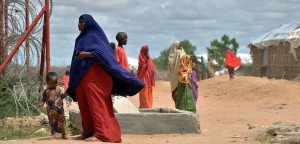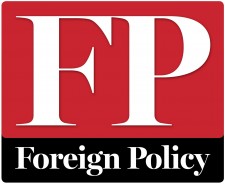At first sight, the Dadaab refugee camp is nothing more than line after line of mud structures and U.N. tents under a relentless sun. Formed in 1991 to house refugees fleeing Somalia’s civil war, it is now a city of nearly half a million people near Kenya’s eastern border. But unlike most cities, Dadaab has been operated by international organizations for almost twenty-five years — and it shows.
 “We basically run Dadaab municipality,” a senior U.N. officer told me with a grin. “I’m playing the role of town clerk, my boss is the mayor, and the taxpayers are the international community.” The international aid workers’ pride in the camp’s orderliness is striking. But what appeals about Dadaab to U.N. bureaucrats doesn’t necessarily make meaningful life possible for the people who live there.
“We basically run Dadaab municipality,” a senior U.N. officer told me with a grin. “I’m playing the role of town clerk, my boss is the mayor, and the taxpayers are the international community.” The international aid workers’ pride in the camp’s orderliness is striking. But what appeals about Dadaab to U.N. bureaucrats doesn’t necessarily make meaningful life possible for the people who live there.
By necessity, refugee camps like Dadaab offer a window into the experiences of a large fraction of the world’s 60 million displaced people. Despite recent efforts by western states to accept more asylum seekers, they can only do so much. Even with the best intentions, only a small fraction of the world’s refugees can be absorbed by distant lands, so refugee crises primarily affect neighboring states. Recent reforms in the U.N.’s refugee policy has centered on finding alternatives to camps, like “refugee self-settlement”: having refugees integrate directly into the host country with no official assistance. But in the U.N., change is implemented slowly, and host states are typically unwilling to allow an influx of refugees to integrate into their societies. So, for the foreseeable future, many refugees will continue to live in camps run by the international community. With the migrant crisis in the spotlight, it is now time to reimagine the refugee camp.
The problems are legion. Few of Dadaab’s residents — who barely play a role in the governance of a community older than many of them — enjoy the opportunity of dignified work. Many face xenophobia and the threat of violence from local Kenyans. Bereft of hope that tomorrow might be better than today, some residents some turn to extremist views or fall prey to military recruiters. The system isn’t working.
In short, refugee camps need reform. Above all else, reform requires the recognition that these sites are here to stay. Though initially built for “temporary” humanitarian emergencies, they often persist for years, if not decades. The Sahrawi refugee camps in western Algeria turned 40 last year. The Palestinian refugee camps in Gaza and the West Bank are over sixty years old. Since these camps offer residents few economic opportunities and no voice in how they’re governed, the issue becomes more than a regrettable temporary inconvenience — it’s a slow-motion human rights disaster.
One fundamental problem is governance. Like all refugee camps operated under the auspices of the U.N. Refugee Agency, Dadaab is designed and governed by the international community. The life of the average refugee is highly regulated, with mandatory participation in dozens of trainings and programs at the block level (groups of 5-6 households). These activities are organized within committees that address issues from water, sanitation and hygiene to gender-based violence to peace-making.
These activities fit within the U.N. system’s so-called “thematic clusters”: health, protection, education, and others. The bureaucratization of the aid sector has made it easier (and cheaper) to finance cookie-cutter programs in camps around the world, rather than designing specific projects for specific needs. But such a rigid, top-down system does not reflect the refugees’ actual priorities, and was never meant for long-term living.
Meanwhile, avenues for refugees to provide feedback on their camp’s operation are limited. Annual elections are held in Dadaab, but refugee leadership has little to no decision-making authority. Buy-in from refugees often means that they have nodded along at the appropriate time in yet another meeting. As a result, refugees’ daily lives are organized according to aid bureaucrats’ plans for dozens of camps and countries rather than being based on the particular ideas and opinions of Dadaab’s residents.
Relaxing camp governance can in Dadaab can solve these problems. The number of mandatory committees and meetings could be reduced dramatically. Refugees could take over every-day camp affairs like service delivery and program management from the international NGOs, and be paid for doing so. Historically, refugees only gained greater control of Dadaab management when it became too risky for the international aid workers to show up. In 2011, Al-Shabab militants kidnapped several aid workers, leading many agencies to pull out of the camp or drastically reduce their presence. And the camp worked just fine.
Refugees could also be encouraged to form autonomous local institutions, forming a genuine civil society to govern life in the camp instead of enduring edicts from the international bureaucracy. The camp can incorporate ways of organizing that are more familiar to camp residents, such as conflict resolution through local practices. With more bottom-up governance, Dadaab can be reconceived as a place where people can exercise their social and political rights. And this, in turn, can curb the radicalization that is so often feared in refugee camps.
In Dadaab, refugees are condemned to a life of dependency and surrounded by host communities that are extremely poor themselves. A few refugees can earn a meager salary (less than $2/day) as “incentive workers” who help implement aid programs. To survive, many depend on remittances from family members outside the camps — but those who have no helpful connections are out of luck. Many citizens in the host state — in this case, Kenya — resent the resources refugees receive. Similarly impoverished, they routinely harass refugees and aid workers alike.
An alternative solution to both of these problems — poverty and conflict — is to allow refugees to become a part of the local economy by arranging for them find employment alongside locals. One option for refugees to access jobs and training is the development of “industrial incubator zones.” In these zones, exceptional and favorable trade laws would attract foreign investment. Businesses would be incentivized to hire both refugees and members of the host community. These incubator zones could even assist in the development of states like Kenya and Jordan while addressing conflict with the host population head-on. And, most importantly, they would allow refugees the basic dignity of work and a chance at financial autonomy.
Current refugee camp policy is a relic of post-WWII practices: create a grid-like container for refugees who will be repatriated as quickly as possible. These camps were never intended to address the needs of a girl who has come of age in a refugee camp and is still there in her 40s, with grown children of her own who have known no life but the camp.
Read more: Reimagining the Refugee Camp
Source: FP



